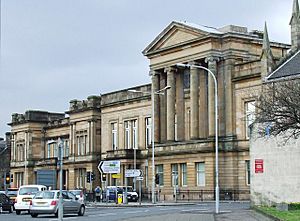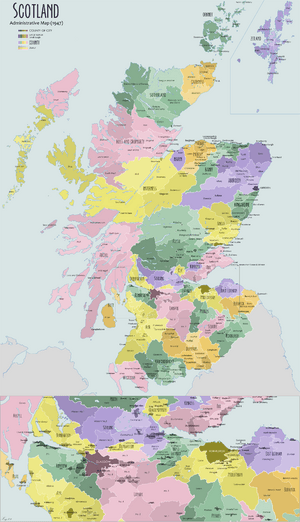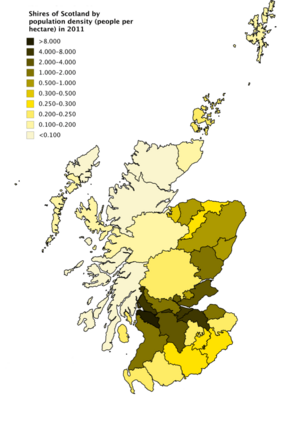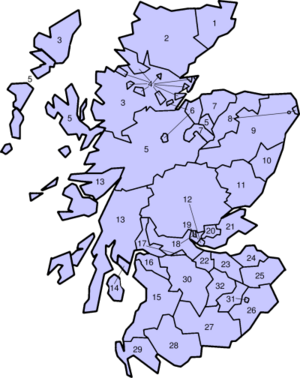Shires of Scotland facts for kids
The shires of Scotland were like old-fashioned counties or areas that helped run the country. They were set up a long, long time ago in the Middle Ages and were used until 1975. At first, they were mainly for legal stuff, like where a judge (called a sheriff) had power. But later, they also helped manage local areas.
After 1975, the shires were no longer used for local government. Scotland now uses council areas instead. Some of these new areas still use old county names, but their borders are often very different. Shires are still used today for things like registering land.
Contents
How Scotland's Shires Began
Early Sheriffdoms and Shires
Kings of Scotland started creating these areas, called sheriffdoms or shires, a long time ago. King Malcolm III (who ruled from 1058 to 1093) was one of the first to bring in sheriffs. These sheriffs were like local officials or judges.
Later kings, especially David I (who ruled from 1124 to 1153), continued to set up more sheriffdoms. They changed older ways of governing into this new system. One of the first shires we know about for sure was Haddingtonshire, mentioned in a document from 1139.
The shires in the Highlands were the last to be fully set up. This happened much later, during the time of King Charles I (1625 to 1649).
Shires in 1305
By 1305, there were 23 shires in Scotland. Edward I of England, who was ruling Scotland at the time, made a list of them. He either appointed new sheriffs or kept the existing ones.
Here are some of the shires that existed by 1305:
- Aberdeen
- Ayr
- Banff
- Berwick
- Clackmannan
- Cromarty
- Dunbarton
- Dumfries
- Edinburgh
- Elgin and Forres
- Fife
- Forfar
- Haddington
- Inverness
- Kincardine
- Kinross
- Lanark (which included the area that later became Renfrewshire)
- Linlithgow
- Peebles
- Perth
- Roxburgh
- Selkirk
- Stirling
- Wigtown
New Shires After 1305
More shires were created after 1305. Some were formed as Scotland grew, and others were made by splitting up existing sheriffdoms. Many of these new shires had strange, uneven borders because they combined different land owned by the sheriffs.
Here are some of the shires formed later:
- Around 1326: Argyll was formed. This area had been taken over by Scotland in 1222.
- 1369: Kirkcudbright was created. It was called a "stewartry" because a "steward" managed it.
- Around 1388: Bute became a shire. It was made up of islands that were part of Argyll.
- 1402: Renfrew was separated from Lanarkshire by King Robert III.
- 1503: Ross and Caithness were formed from parts of Inverness-shire. This was done by an act of parliament during the reign of King James IV.
- 1581: Orkney was given the right to have its own sheriff.
- 1633: Sutherland was separated from Inverness-shire. This new county was officially confirmed by the Scottish Parliament in 1633.
Changes After 1707: End of Hereditary Rule
From the 1600s, shires started to be used for more than just legal matters. They also helped with local administration, like collecting taxes.
After Scotland joined with England in 1707 to form Great Britain, the government wanted to make Scotland's local rule more like England's. However, many sheriff jobs had become "hereditary," meaning they were passed down in certain families. This made it hard to change things.
After the Jacobite Rising of 1745 (a rebellion), the government decided to make big changes. In 1747, a law was passed that took away these hereditary sheriff jobs. The government paid the families who lost their positions. This made it easier for the Crown (the monarch) to control the shires.
Later, in 1794, "Lord-Lieutenants" were appointed to each county. These were important people who represented the monarch. This helped bring Scotland's local government more in line with the rest of Great Britain.
Modern Changes to Counties

In 1858, police forces were set up in each shire. Big towns, called "burghs," usually had their own rules and were not fully controlled by the shire authorities.
In 1889, new "county councils" were formed. These councils managed the "administrative counties," which were similar to the old shires but not exactly the same. Some small, detached parts of counties were removed. Also, Ross-shire and Cromartyshire were joined together to form Ross and Cromarty. Four big cities – Aberdeen, Dundee, Edinburgh, and Glasgow – became "counties of cities," meaning they had their own councils.
In 1929, some county councils were combined. For example, Perth and Kinross shared one council. Even though they shared a council, each county was still officially separate.
By the 1960s, the government wanted to make local government even simpler. They thought about reducing the number of counties. A special group, the Royal Commission on Local Government in Scotland, suggested replacing the counties with larger "regions."
Finally, in 1973, a new law was passed that officially ended the use of counties for local government. From May 16, 1975, counties were replaced by new "regions" and "districts."
Local government changed again in 1994. The regions and districts were replaced by the council areas we have today. These councils handle all local government tasks in their area.
The historic counties of Scotland are still listed in official records, connecting places to their traditional areas.
Names of the Shires
In old official papers, shires were often called "the Shire of X," like "the Shire of Dumbarton." But in everyday talk, people would say "Dumbartonshire."
Old maps from the late 1600s and 1700s show how the shire names were written. For example, some maps showed "Berwick Shire" or "Roxburgh Shire."
Many shires also had other names that were used for a long time. Here are some examples:
- Angus was also called Forfarshire
- East Lothian was also called Haddingtonshire
- Kincardineshire was also called The Mearns
- Midlothian was also called Edinburghshire
- Moray was also called Elginshire
- Peeblesshire was also called Tweeddale
- Roxburghshire was also called Teviotdale
- Selkirkshire was also called Ettrick Forest
- West Lothian was also called Linlithgowshire
Today, the word "county" is used more often than "shire." "Shire" sounds a bit more old-fashioned or poetic.
Lists of Shires
Counties Until 1890
The map above shows many small parts of counties that were physically separate from the main county area. For example, Cromartyshire had very scattered borders, which were set as late as 1685.
Counties from 1890 to 1975
| Counties of Scotland from 1890 to 1975 | |
|---|---|
|
 |
See also
 In Spanish: Condados de Escocia para niños
In Spanish: Condados de Escocia para niños




